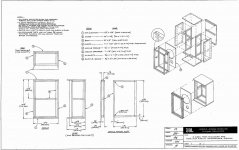Hi!
I want to build a pair of speakers for my room.
Bought a pair of 8" cones but had problems trying to find tweeters that could match that high SPL...Long story short. I returned them and got a pair of 8cx300ND drivers and a pair of fd250 crossovers.
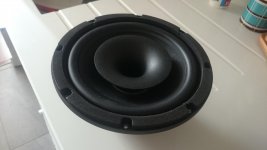
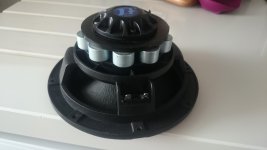
And here, the specs.
Beyma Coaxial Speakers - Beyma 8CX300Nd/N coaxial speakers - Beyma 8CX300Nd/N 340 watt 8" coaxial speakers for all 2-way applications. Beyma 8CX300Nd/N coxial speaker and other Beyma 10" coaxial speakers here.
Beyma Crossovers - Beyma FD-250 crossover - Beyma FD-250 2-way passive 2.0kHz crossover. The Beyma FD-250 crossover is rated at over 500 watts RMS. Beyma crossovers here.
Those drivers are used in the Dynamikks 8.2 and 8.3 monitors and I hope I can get a good sound using them.
Need your help to design the cabinets.
I need they have a certain angle, like Sonus Fabers. Something like that:
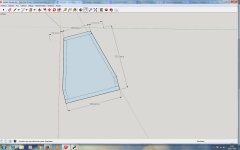
And they will be positioned like this.
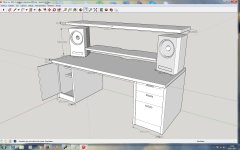
I think you get the idea.
With the dimensions you see in the photos the cabinets are around 30 liters volume.
I´d like to know if I´ll have reflex problems or distortion for using that shape for the cabinet and how would you tune that box for those drivers. I mean, what is the lowest freq I could achieve without damaging the speakers.
Thanks a lot for your help.
David
I want to build a pair of speakers for my room.
Bought a pair of 8" cones but had problems trying to find tweeters that could match that high SPL...Long story short. I returned them and got a pair of 8cx300ND drivers and a pair of fd250 crossovers.


And here, the specs.
Beyma Coaxial Speakers - Beyma 8CX300Nd/N coaxial speakers - Beyma 8CX300Nd/N 340 watt 8" coaxial speakers for all 2-way applications. Beyma 8CX300Nd/N coxial speaker and other Beyma 10" coaxial speakers here.
Beyma Crossovers - Beyma FD-250 crossover - Beyma FD-250 2-way passive 2.0kHz crossover. The Beyma FD-250 crossover is rated at over 500 watts RMS. Beyma crossovers here.
Those drivers are used in the Dynamikks 8.2 and 8.3 monitors and I hope I can get a good sound using them.
Need your help to design the cabinets.
I need they have a certain angle, like Sonus Fabers. Something like that:

And they will be positioned like this.

I think you get the idea.
With the dimensions you see in the photos the cabinets are around 30 liters volume.
I´d like to know if I´ll have reflex problems or distortion for using that shape for the cabinet and how would you tune that box for those drivers. I mean, what is the lowest freq I could achieve without damaging the speakers.
Thanks a lot for your help.
David
Last edited:
Really you want to try a program like WinISD. It will model your speaker in the cabinet to see the frequency response. It can pick an optimum cabinet volume and reflex port and you can tweak them to see how the frequency response changes.
The cabinet shape looks good - you need to work out how you are going to brace it to make it rigid and how you are going to line or stuff it to help with internal reflections.
Brian
The cabinet shape looks good - you need to work out how you are going to brace it to make it rigid and how you are going to line or stuff it to help with internal reflections.
Brian
Why didn't you buy the crossover Beyma makes specifically for your driver (FD-2CX)?
As for the box you can make almost any shape as long as you stick to the required volume. In your case I'd say 20-30L tuned to driver Fs (61Hz).
That'll give you the EBS alignment Pee mentioned. Standard alignment gives you a tiny box (<10L) and no bass to speak of.
As for the box you can make almost any shape as long as you stick to the required volume. In your case I'd say 20-30L tuned to driver Fs (61Hz).
That'll give you the EBS alignment Pee mentioned. Standard alignment gives you a tiny box (<10L) and no bass to speak of.
Last edited:
Brian, I tried winISD and for that cabinet volume, if I want to get 45-50 hz. The graph shows a big db drop at lower freqs. Dont know what im doing wrong or how to improve that.
Regarding internal reflections, how can I avoid them? Some foam inside the cabinet? But, doing that wont reduce the internal volume? Ebs aligment? I have to study that. Sorry, but dont know what is it.
Pete, those 8.2 dont have subwoofer, so Id like to build something like that.
I bought that crossover because the Fd2cx has a 2,6khz xo freq and the seller told me is too much for an 8". Do you think is right or should I use other xo model.
Thanks a lot for your answers.
Regarding internal reflections, how can I avoid them? Some foam inside the cabinet? But, doing that wont reduce the internal volume? Ebs aligment? I have to study that. Sorry, but dont know what is it.
Pete, those 8.2 dont have subwoofer, so Id like to build something like that.
I bought that crossover because the Fd2cx has a 2,6khz xo freq and the seller told me is too much for an 8". Do you think is right or should I use other xo model.
Thanks a lot for your answers.
Last edited:
Not sure that forcing a 45Hz response out of a driver with an Fs of 61Hz is a good idea.
In fact I am almost certain that is not.
As for the EBS can have a visual of that if you use winISD or ISDonline.
Type in the required T/S parameters and click 'optimum' and 'draw it'.
This will give you a tiny box tuned to 90Hz or so. Below 90Hz the response drops at 24dB/oct.
Now change the tuning to 61Hz and increase the volume to 20-30L and click 'draw it'.
You'll get a response tha drops 3dB or so at 120Hz and then remains at that level down to 60Hz before dropping at 24dB/oct.
I would have thought it'd be a better idea to buy the xover Beyma designed specifically for this driver and use for their measurements rather than a generic one. It also includes the required level matching between tweeter and woofer.
Definitely use foam on the inside of the cab. Everywhere except the baffle and probably double behind the driver.
If anything foam will increase the apparent volume to the driver but only by a minimal amount.
In fact I am almost certain that is not.
As for the EBS can have a visual of that if you use winISD or ISDonline.
Type in the required T/S parameters and click 'optimum' and 'draw it'.
This will give you a tiny box tuned to 90Hz or so. Below 90Hz the response drops at 24dB/oct.
Now change the tuning to 61Hz and increase the volume to 20-30L and click 'draw it'.
You'll get a response tha drops 3dB or so at 120Hz and then remains at that level down to 60Hz before dropping at 24dB/oct.
I would have thought it'd be a better idea to buy the xover Beyma designed specifically for this driver and use for their measurements rather than a generic one. It also includes the required level matching between tweeter and woofer.
Definitely use foam on the inside of the cab. Everywhere except the baffle and probably double behind the driver.
If anything foam will increase the apparent volume to the driver but only by a minimal amount.
Thanks Charles, will try that on winISD when I get home.
Will take your advice and wont go as low.
The specific xover (Fd2cx) is designed for the 5,6 and 8 inches models. It is 2,6khz 24db slope. So I bought a 2khz 12db slope. It has jumpers to select -3db at 3,5k and -3,-6 or -7,5db for hf. I thought I could tune better that one, but now you make me doubt about it.
Do I keep the Fd250 or return it, thats the question.
Thanks!
Will take your advice and wont go as low.
The specific xover (Fd2cx) is designed for the 5,6 and 8 inches models. It is 2,6khz 24db slope. So I bought a 2khz 12db slope. It has jumpers to select -3db at 3,5k and -3,-6 or -7,5db for hf. I thought I could tune better that one, but now you make me doubt about it.
Do I keep the Fd250 or return it, thats the question.
Thanks!
The main problem of taking an 8" up to 2.6k is usually beaming but I suppose the horn thing helps dispersion because looking at Beyma's pdf it looks pretty good and continuous.
However their distortion graph (bless Beyma for having the decency to publish any!) for the tweeer part shows a peak between 1.6 and 2.5kHz. The higher xover frequency with a steeper slope should help with that.
Also it seems that you need to pad the tweeter down by 8 or 10dB.
I have not heard or worked with the driver but going by the published data I think the FD2CX would be much more suitable than the one you bought.
However their distortion graph (bless Beyma for having the decency to publish any!) for the tweeer part shows a peak between 1.6 and 2.5kHz. The higher xover frequency with a steeper slope should help with that.
Also it seems that you need to pad the tweeter down by 8 or 10dB.
I have not heard or worked with the driver but going by the published data I think the FD2CX would be much more suitable than the one you bought.
If You have idea to listen to these speakers that close sitting with the computer, that is very good way to get outside in the open space. Don't get me wrong please,  but You will stand short time in-front. The beaming and decibels will fried you out sweet spot. lowering the levels would not help
but You will stand short time in-front. The beaming and decibels will fried you out sweet spot. lowering the levels would not help 
Definitely use foam on the inside of the cab.
I think the felt behaves better
How to Use Sound-Damping and Acoustic Materials in DIY Loudspeakers
Everywhere except the baffle and probably double behind the driver.
" ...............a sound absorbing material, such as fiberglass should be glued or stapled so that it covers the inside of the enclosure.
baffle will inset in front. Glued and screw in place. "
( See attached photo )
http://www.diyaudio.com/forums/multi-way/298472-infinity-sm-62-bookshelf-diy-upgrade-3.html
( see post 28 )
I would like someone to explain to me technically because no absorbent material should be placed in the baffle itself. Many years ago I followed JBL's instructions to the letter, did I misunderstand? Should I remove the fiberglass from the front panel? Why ?
Attachments
Personally I think co-axial are excellent as nearfields.
I'm using 12" Tannoys myself! ;-)
I agree, and far field too, I can move quite off the axis and the sound does not change too much.
I've used 8G40 drivers in downtuned BR's, just as Beyma says in the PDF.
The thing is that these drivers can take one h*ll of power.
They just need a lot of eq...
I have also tested 2x 8G40 and a cp380 driver i backloaded horn tuned to 45hz.
500w was no problem without low cut filter !
Your drivers work well in many diffrent boxes, but will need a lot of eq to play down to about 45hz. I have listened to them in BLH and BR. As Zoran say's they need some space to the listener to work well, then you will have a very detailed and clear sound.
Regards
Figge
The thing is that these drivers can take one h*ll of power.
They just need a lot of eq...
I have also tested 2x 8G40 and a cp380 driver i backloaded horn tuned to 45hz.
500w was no problem without low cut filter !
Your drivers work well in many diffrent boxes, but will need a lot of eq to play down to about 45hz. I have listened to them in BLH and BR. As Zoran say's they need some space to the listener to work well, then you will have a very detailed and clear sound.
Regards
Figge
That article is simplistic, out-dated, and wrong. A little searching should turn up materials with broadband sound absorption, appropriate thickness, and proper placement techniques.
Last edited:
That article is simplistic, out-dated, and wrong. A little searching should turn up materials with broadband sound absorption, appropriate thickness, and proper placement techniques.
Perhaps they should specify where low frequencies begin and end ?
Close-up acoustic foam.
Generally available in two shapes / profiles, flat and egg box, the foam family are usually opaque in colour and have a closed cell construction, The foam cells are chosen to be a specific size / diameter in order to provide a bulk material characteristic suitable for acoustic damping, i.e. the cells are mostly airtight and provide resistance to the passage of air if you try to blow through the material. This closed cell structure absorbs energy when the cell content, air, is compressed and rarefied due to the sound pressure wave. This type of damping is used to alter the high frequency response of cabinets and transmission lines. It does not work well for low frequencies as the amount of damping / energy absorption which the foam can support is relatively small.
Perhaps they should specify where low frequencies begin and end ?
Close-up acoustic foam.
Generally available in two shapes / profiles, flat and egg box, the foam family are usually opaque in colour and have a closed cell construction, The foam cells are chosen to be a specific size / diameter in order to provide a bulk material characteristic suitable for acoustic damping, i.e. the cells are mostly airtight and provide resistance to the passage of air if you try to blow through the material. This closed cell structure absorbs energy when the cell content, air, is compressed and rarefied due to the sound pressure wave. This type of damping is used to alter the high frequency response of cabinets and transmission lines. It does not work well for low frequencies as the amount of damping / energy absorption which the foam can support is relatively small.
I'm not following...
- Status
- This old topic is closed. If you want to reopen this topic, contact a moderator using the "Report Post" button.
- Home
- Loudspeakers
- Multi-Way
- Help 8" coax project.
